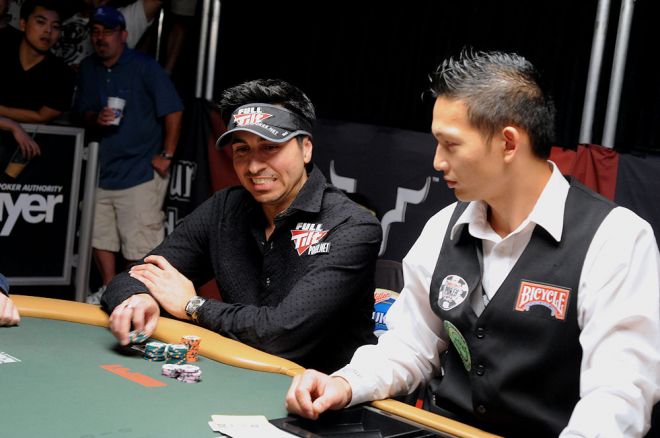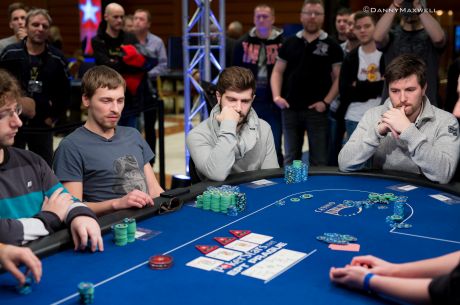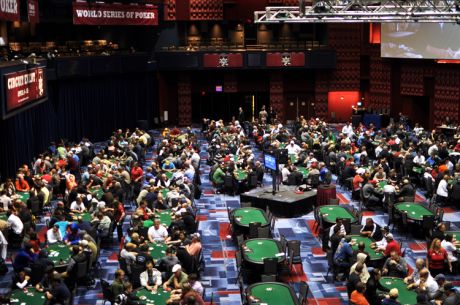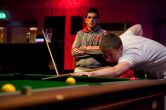Looking at a Final Table All-In Bluff

Covering live poker tournaments for a living affords me the opportunity to see countless thousands of hands played out, many of which offer interesting and potentially valuable insights into how players �� both amateurs and professionals �� play the game. In this ongoing series, I��ll highlight hands I��ve seen at the tournaments I��ve covered and see if we can glean anything useful from them.
The Scene
Five players remain in the $675 buy-in RunGood Cup Championship, with a $54,687 payday up top. RunGood Pro Ryan Tepen has a huge chip lead with about 40 percent of what��s in play, with everyone else averaging around 30 big blinds at Level 23 (15,000/30,000/4,000).
Both Tim Woodson and Patrick Eskandar (pictured above) find themselves at the final table after having played together earlier on Day 1b. In a hand that day, Woodson three-bet Eskandar on the button and bluffed him on the flop, showing king-four offsuit after Eskandar folded.
The Action
Woodson raised to 75,000 from the button after two folds in front of him, then Chris Torres called from the small blind as did Eskandar from the big. The flop came 7?7?A?, and action checked to Woodson. He bet 125,000. Torres folded, but Eskandar pushed all in for 205,000 more. Woodson tanked a while and folded, saying he had two nines.
Eskandar tossed 10?6? face up into the muck and dragged the pot.
Concept and Analysis
Whether or not Woodson had two nines, it��s pretty standard to raise from the button here with anything decent, and after he does he sees both blinds defend with calls. The flop of 7?7?A? is a tough one to hit, so Woodson fires a continuation bet knowing it��s likely his opponents have nothing.
Torres folds, and Eskandar shoves all in with a total airball. It��s an interesting play for a few reasons.
Many players, myself included, would usually advocate bluffing for stacks only with hands that have some sort of equity �� for example, at least a couple of overcards or a gutshot. However, if you��re going to shove with absolute air, this spot does check a few of the necessary boxes.
First of all, Eskandar knows that Woodson is a good player who is capable of making moves and willing to play his position. Now, most players these days are fully aware they should play a wider range on the button. But Eskandar had concrete proof as Woodson had already shown him he was comfortable playing a wide range on the button with the earlier king-four bluff, something Eskandar clearly remembered.
Second, it��s believable that Eskandar has a strong hand here. Of course, he would probably shove good aces preflop, so his value range can be narrowed to hands containing a seven and possibly weak ace-high hands. Eskandar could certainly have trips here, though, as he was getting a great price of almost 4-to-1 to call preflop, so he definitely would be playing lots of hands containing a seven.
Finally, this is a flop that is going to miss the vast majority of hands. That��s key because if Woodson does have something, Eskandar is almost certainly getting snapped off. Shoving for 205,000 into a pot of almost 500,000 means he��s giving Woodson a great price on a call. Therefore, he can only do this on a board Woodson usually misses.
All in all, this is an extremely risky play, but given the circumstances, it��s one that has a good shot of success. Eskandar��s well-timed bluff didn��t end up helping him, as he busted fifth for $11,679, while Woodson finished runner-up to Tepen for $33,763.
Want to stay atop all the latest in the poker world? If so, make sure to get PokerNews updates on your social media outlets. Follow us on Twitter and find us on both Facebook and Google+!









